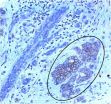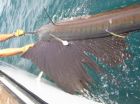Measuring fatigue through the voice
Australian researchers show that speech 'flattens' after 24 hours awake
2010-12-23
(Press-News.org) WASHINGTON, D.C., December 22, 2010 -- What can scientists learn from watching a group of people sitting around, chatting, playing movies, reading, and happily making new friends? Quite a lot, says University of Melbourne, Australia acoustician Adam Vogel, who carefully observed this sort of group in a fatigue management study he and his colleagues describe this month in The Journal of the Acoustical Society of America.
Their report shows the effects of sustained wakefulness on speech and describes a novel method to acoustically analyze the effects of fatigue on the central nervous system as revealed through speech.
The findings are significant to workers, employers, public safety officials, and military leaders who are concerned with managing fatigue over long shifts, notes Vogel.
"There is increasing interest in the development of objective non-invasive systems that can be used to assist the identification and management of fatigue in both health and workplace settings," he says.
Measuring fatigue by analyzing a person's speech and quantifying any changes from their normal, rested speech may enable doctors to make objective decisions about a person's ability to function in a work environment. It may also be a useful tool for monitoring fatigue in clinical trials where alertness is a key measured outcome.
The Australian study involved 18 young adults who provided speech samples (sustained vowels, reading counting and reading tasks) every two hours. Vogel and his colleagues looked at components of speech such as length of pauses and total time to complete a spoken task. Their results showed that as fatigue progresses, speech slows and variations in pitch increase and tone diminishes. Their conclusion is that we have less control over the muscles that produce speech as we become more and more tired."Although remaining awake for 24 hours is physically and mentally exhausting, it's actually a great way to make new friends," notes Vogel. "Most of them just entertained themselves between testing by watching movies, reading or talking amongst themselves."
###
The article, "Acoustic analysis of the effects of sustained wakefulness on speech" by Adam P. Vogel, Janet Fletcher, and Paul Maruff appears in The Journal of the Acoustical Society of America. See: http://scitation.aip.org/JASA.
Journalists may request a free PDF of this article by emailing jbardi@aip.org
JOURNAL OF THE ACOUSTICAL SOCIETY OF AMERICA
Since 1929, The Journal of the Acoustical Society of America (JASA) has been the leading source of theoretical and experimental research results in the broad interdisciplinary subject of sound. Subject coverage includes: linear and nonlinear acoustics; aeroacoustics, underwater sound and acoustical oceanography; ultrasonics and quantum acoustics; architectural and structural acoustics and vibration; speech, music and noise; psychology and physiology of hearing; engineering acoustics, sound transducers and measurements; bioacoustics, animal bioacoustics and bioresponse to vibration. See: http://scitation.aip.org/JASA
ABOUT THE ACOUSTICAL SOCIETY OF AMERICA
The Acoustical Society of America (ASA) is the premier international scientific society in acoustics devoted to the science and technology of sound. Its 7,500 members worldwide represent a broad spectrum of the study of acoustics. ASA publications include The Journal of the Acoustical Society of America -- the world's leading journal on acoustics -- Acoustics Today magazine, books, and standards on acoustics. The society also holds two major scientific meetings each year. For more information about ASA, visit our website at: http://asa.aip.org
END
ELSE PRESS RELEASES FROM THIS DATE:
2010-12-23
Gaithersburg, MD – On December 14-15, 2010, the U.S. Food and Drug Administration (FDA) convened an Advisory Panel to discuss several scientific issues that may affect the regulation of dental amalgam. At the conclusion of the hearing, the Panel voted to recommend that the FDA conduct further review of the material's safety.
The meeting comes on the heels of a July 2009 Final Rule (http://bit.ly/FDA2009FinalRule) from the FDA that reclassified dental mercury from a class I device to a class II device and designated special controls for dental amalgam, mercury and amalgam ...
2010-12-23
PHILADELPHIA – Overexpression or hyperactivation of ErbB cell-surface receptors drives the growth of many breast cancers. Drugs, like Herceptin, that block the receptors' signals halt tumor progression in some patients. However, not all patients' tumors respond, with some becoming resistant over time. Different drugs that interfere with other steps in the signaling pathway may improve the response of patients, yet little is known about these molecules.
Now, Marcelo G. Kazanietz, PhD, professor of Pharmacology at the University of Pennsylvania School of Medicine and colleagues, ...
2010-12-23
Researchers at The Wistar Institute announce the release of an online tool that will help scientists find "gene promoters"—regions along a DNA strand that tell a cell's transcription machinery where to start reading in order to create a particular protein. The Mammalian Promoter Database (MPromDb) integrates the genome sequencing data generated at Wistar with publicly available data on human and mouse genomics. MPromDb pinpoints known promoters and predicts where new ones are likely to be found, the researchers say.
"Several complete genome sequences are available, including ...
2010-12-23
Researchers have discovered evidence of a distinct group of "archaic" humans existing outside of Africa more than 30,000 years ago at a time when Neanderthals are thought to have dominated Europe and Asia. But genetic testing shows that members of this new group were not Neanderthals, and they interbred with the ancestors of some modern humans who are alive today.
The journal Nature reported the finding this week. The National Science Foundation's Behavioral and Cognitive Sciences Division partially funded the research.
An international team of scientists led by Svante ...
2010-12-23
Billfish and tuna, important commercial and recreational fish species, may be more vulnerable to fishing pressure because of shrinking habitat, according to a new study published by scientists from NOAA, The Billfish Foundation, and University of Miami Rosenstiel School of Marine and Atmospheric Science.
An expanding zone of low oxygen, known as a hypoxic zone, in the Atlantic Ocean is encroaching upon these species' preferred oxygen-abundant habitat, forcing them into shallower waters where they are more likely to be caught.
During the study, published recently in ...
2010-12-23
MADISON – To survive in a tumultuous environment, sea urchins literally eat through stone, using their teeth to carve out nooks where the spiny creatures hide from predators and protect themselves from the crashing surf on the rocky shores and tide pools where they live.
The rock-boring behavior is astonishing, scientists agree, but what is truly remarkable is that, despite constant grinding and scraping on stone, urchin teeth never, ever get dull. The secret of their ever-sharp qualities has puzzled scientists for decades, but now a new report by scientists from the ...
2010-12-23
CORVALLIS, Ore. – Marine ecologists at Oregon State University have shown for the first time that tiny fish larvae can drift with ocean currents and "re-seed" fish stocks significant distances away – more than 100 miles in a new study from Hawaii.
The findings add credibility to what scientists have believed for some time, but until now been unable to directly document. The study also provides a significant demonstration of the ability of marine reserves to rebuild fishery stocks in areas outside the reserves.
The research was published this week in PLoS One, a scientific ...
2010-12-23
Researchers at the University of Minnesota have discovered how HIV binds to and destroys a specific human antiviral protein called APOBEC3F. The results suggest that a simple chemical change can convert APOBEC3F to a more effective antiviral agent and that shielding of a common feature shared by related proteins may yield a similar outcome.
This discovery highlights the potential for a novel approach to combating HIV/AIDS that would seek to stabilize and harness the innate antiviral activity of certain human proteins, according to lead author John Albin, a researcher ...
2010-12-23
BUFFALO, NY (December 22, 2010) -- Experiments by a team of researchers in New York and New Jersey have generated evidence that questions the common belief that the pterygotid eurypterids ("sea scorpions") were high-level predators in the Paleozoic oceans. This group, which ranged the seas from about 470 to 370 million years ago (long before the dinosaurs appeared), included the largest and, arguably, scariest-looking arthropods known to have evolved on planet Earth. Reaching lengths of 2 ½ meters with a body supported by well-developed legs, and armed with a pair of forward-facing ...
2010-12-23
In a breakthrough that could lead to new treatments for patients with malignant melanoma, researchers from Mount Sinai School of Medicine have discovered that a particular protein suppresses the progression of melanoma through regulation of an oncogene, or gene responsible for cancer growth. The study is published in the December 23 issue of Nature.
Researchers studied the natural progression of melanoma using mouse and human cells, as well as patient samples and determined that the presence of a specific histone variant, which is a protein that helps package DNA, was ...
LAST 30 PRESS RELEASES:
[Press-News.org] Measuring fatigue through the voice
Australian researchers show that speech 'flattens' after 24 hours awake


